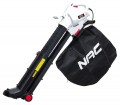Air flow (blowing)
Performance of the garden vacuum cleaner when blowing (see "Operating mode").
This parameter determines the amount of air that the device distills through itself in a certain time. It should be noted that it depends not only on the speed of this air, but also on other parameters — for example, the diameter of the pipe. Therefore, two models with the same performance can noticeably differ in speed, and vice versa. You also need to keep in mind that the efficiency of "purging" bottlenecks with stuck debris does not depend on performance, but on the flow rate. On the other hand, good performance makes it easier to work on large areas, as allows you to simultaneously cover a large area with a jet of air.
Most modern garden vacuum cleaners in blowing mode provide up to 15 m / min;
higher rates are typical mainly for professional models.
Garbage container volume
The volume of the garbage collector — a container for garbage — regularly supplied with a garden vacuum cleaner. The larger the bin, the more debris can fit inside and the less often you have to empty it during work. On the other hand, a capacious container has the appropriate dimensions, and when filled, it also weighs a lot, which can affect the ease of use of the vacuum cleaner (this is especially true for manual and backpack models, see "Type"). Therefore, manufacturers tend to choose bins for their products based on the overall level of the vacuum cleaner and the scale of work for which it is designed. And some units may not be equipped with complete containers at all — in the expectation that the user picks up such a container separately.
The volume of the garbage can can be approximately estimated, knowing that an ordinary household bucket holds about 10 – 12 liters. Thus, for example, a 35 liter container corresponds approximately to three standard buckets.
Motor power
Power of the garden vacuum cleaner motor, expressed in watts. This unit is by far the main one, it is used for both electric and gasoline engines (see "Engine type").
The
more powerful the motor — the more air the vacuum cleaner is able to pass through itself, the greater the speed it is able to give the air flow and the more efficient the chopper (if there is one at all — see "Operating mode"). At the same time, all these moments depend not only on power, but also on many other design features; and manufacturers select each motor in such a way as to provide the vacuum cleaner with certain performance characteristics. Therefore, when choosing, it is worth looking primarily at practical characteristics (flow rate, blowing and suction performance), and engine power is of secondary importance.
Shoulder strap
Shoulder
strap included with garden vacuum cleaner.
This accessory is found only in models of the manual type (see above): knapsacks, by definition, are carried behind the back, and other types do not imply transportation by hand at all. When using a shoulder strap, most of the weight of the unit is transferred from the hands to the shoulder; this improves wearing comfort and makes it easier to work with the vacuum cleaner for a long time.
Weight
The total weight of the garden vacuum cleaner. Usually, this paragraph indicates the "net" weight of the unit — with an empty dust container (or even without a dust container at all), without fuel and oil (in models with an internal combustion engine, see "Engine type"), without a battery (in the corresponding devices, also see "Engine type"), etc. This parameter is important primarily for models designed to
be carried "on oneself" — that is, hand-held and knapsack (see "Type").

